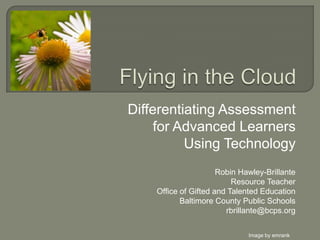
Robin Hawley-Brillante
- 1. Differentiating Assessment for Advanced Learners Using Technology Robin Hawley-Brillante Resource Teacher Office of Gifted and Talented Education Baltimore County Public Schools rbrillante@bcps.org Image by emrank
- 2. Content • What is taught and when it is taught Process or Instructional Strategies • How content is taught Products • Opportunities
- 3. Using differentiation in the classroom means designing and implementing curriculum, teaching strategies, and assessments to meet the needs, interests, and abilities of all students. Kirchner & Inman, 2005
- 4. Play – The capacity to experiment with one’s surroundings as a form of problem- solving Performance — The ability to adopt alternative identities for the purpose of improvisation and discovery Simulation — The ability to interpret and construct dynamic models of real-world processes Media and Learning by Henry Jenkins et al from MIT, “Confronting the 1Digital Challenges of Participatory Culture: Media Education for the 21st Century”
- 5. Appropriation — the ability to meaningfully sample and remix media content Collective Intelligence — the ability to pool knowledge and compare notes with others toward a common goal Judgment — the ability to evaluate the reliability and credibility of different information sources
- 6. 1. Identify the core concept • What is the core concept, skill, or idea that you want to teach? 2. Develop learning goal(s) • What do you want your learners to understand by completing this activity? 3. Research • Conduct brainstorms, discussions, and online searches to generate ideas about how to communicate the concept to your learners. • Challenges are multimedia and interactive, featuring not only text but media elements (images, video, audio web links to online tools and games). 4. Create or find media elements that will: • Demonstrate the concept • Engage your learners • Connect well to your learners’ lifestyles and experiences
- 7. Usingyour research, put your challenge together. • Four main challenge components (use all, in any order): Concept Concept in context Your Turn Share it • Other challenge components (use as needed, in any order): What about You? Reflect Further Resources
